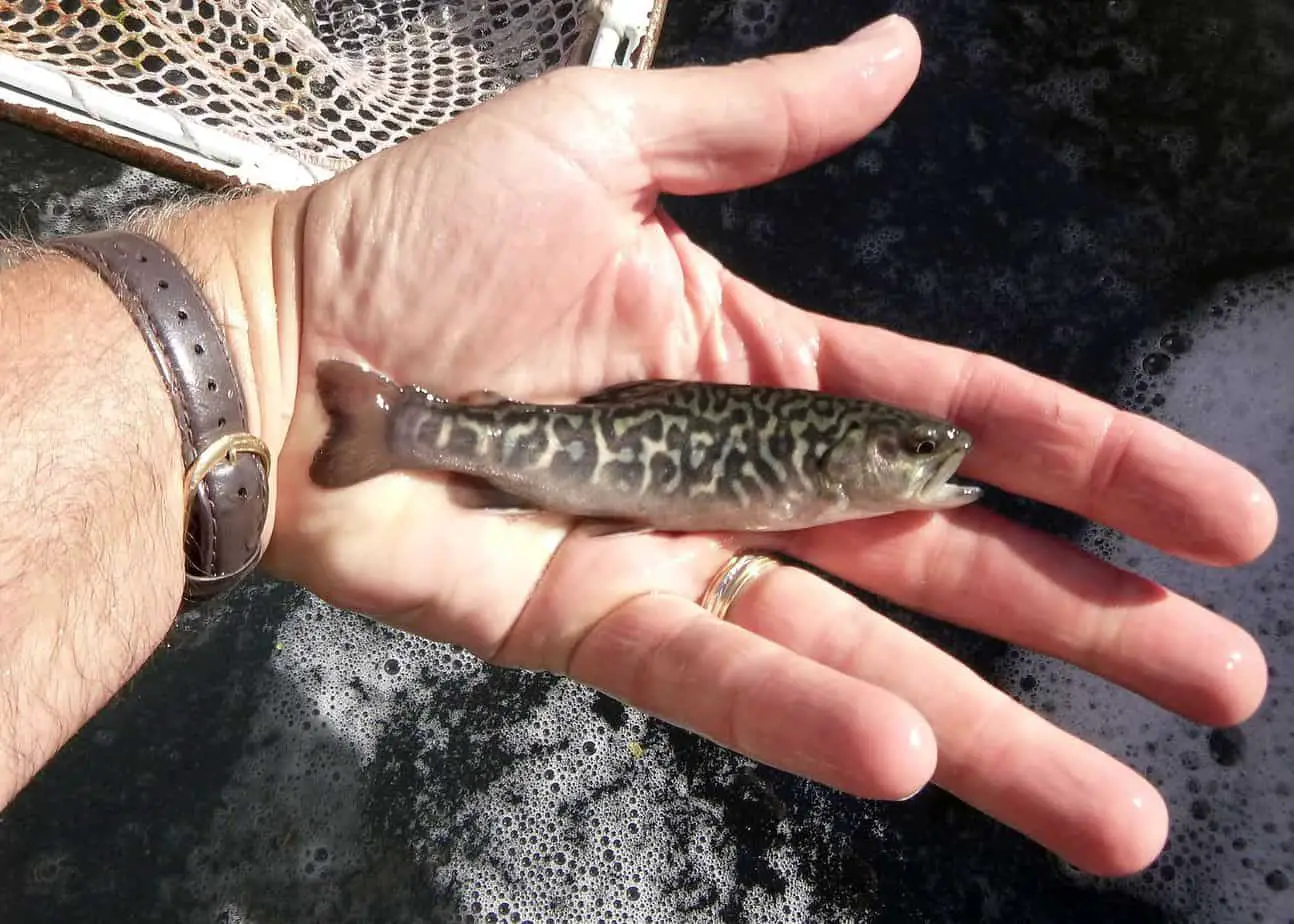The tiger trout is a freshwater fish that can be found in the United States and Canada. It is closely related to brown and brook trout, but its orange-yellow hue makes this species unique. This beautiful coloration comes from different pigments that are used for defense against predators.
Tiger trout live primarily in small streams where they feed on insects, worms, other invertebrates, and smaller fish. Catching one of these elusive creatures can be difficult as they prefer to stay deep in dark pools with many hiding spots like undercut banks or rocky ledges. If you’re interested in trying your hand at catching one of these fishy beauties, here’s what you need to know before you go!
What is a Tiger Trout?
The Tiger Trout is a hybrid of Brown Trout and Brook Trout. Tiger trout are uncommon in the wild but are stocked in many lakes and rivers.
The tiger trout is called a “genetic chimera,” meaning they have one set of chromosomes from the brown trout parent. Still, their DNA comes from both parents – making it what geneticists call an “allotetraploid.” It has come to be known as such because its genome contains three sets of each chromosome for a total of 78 chromosomes instead of just two, which most species possess.
Tiger trout have a deep range in what it eats but primarily feeds on insects, worms, small fish, and invertebrates.
Tiger trout live in smaller streams where they can most easily find what it needs to survive. They are nervous feeders, so you may only see them occasionally, if at all near the surface, before they quickly go back down into the depths with their catch.
Tiger trout can look very similar to Amur Trout or Siberian Brown Trout.
Where to find a Tiger Trout?
Tiger trout are most commonly come from fisheries and are stocked in various states like Utah and West Virginia. Still, Tiger Trout have been stocked throughout the country, which offers anglers various spots to try and land one.
The most popular destinations for catching tiger trout are in northern states like New York, Pennsylvania, Michigan, Wisconsin, and Maine.
Tiger Trout are found naturally in Clear Creek, Colorado; Raystown Lake, Pennsylvania; and the Allegheny River Basin of New York State.

How to catch a Tiger Trout.
Catching one of these elusive creatures can be difficult as they prefer to stay deep in dark pools with many hiding spots like undercut banks or rocky ledges.
You also want a lot of current. The most important thing about fishing for tiger trout is keeping them out from under banks where they can hide.
They are called a “nervous feeder,” meaning they don’t like to be near the surface and will only come out for quick attacking bites before quickly going back down into their hiding spot.
Tiger trout have been known to take artificial flies, live worms, dough balls on a dropper line, Powerbait, or even small spinners; however, these fish tend not to chase after baits, so it’s important to cover the water thoroughly when casting.
A short-casting technique with lots of pauses can also help entice them from their hiding spots towards your hook, where hopefully, they’ll make an appearance!

Top Tips for catching Tiger Trout
- The best time of year to catch them is during the spawning season, from early July to late September.
- When fishing for Tiger Trout, you should use an 8-10 weight fly rod with a floating line or a 7-weight rod with sinking tip lines.
- You can also use bait if you prefer not to fly fish – just make sure it’s something they’re attracted to.
- Keep an eye out for undercut banks where they like to hide.
- Try using flies like Woolly Buggers or Hare’s Ear Nymphs to increase your chances of catching one.
- The best time to catch tiger trout is during the summer months when they are most active and feeding heavily on insects, worms, other invertebrates & smaller fish. However, they may sometimes be seen as early as February and March.
- The best time for catching Tiger Trout is in the early morning hours, when they will be more active near the surface feeding.
- Try fishing in shallow water that’s around 18 inches deep. The trout are more likely to come out and grab what it sees.
- Cast your line at an angle near submerged logs or rocks.
- Use a floating line when fishing for tiger trout.
- Cast upstream into a pool and allow the current to carry your fly downstream to what you are fishing.
- Whenever possible, use long leaders: they allow more time for tiger trout to see or what’s happening with your line.
Conclusion
The Tiger Trout is an uncommon hybrid fish that you’ll mostly find in a stocked lake or river. From Utah to West Virginia and Michigan to Maine, these elusive creatures are known for their preference for deep pools with many hiding spots like undercut banks or rocky ledges.
Tiger trout can be challenging to land, but these beautiful fish are worth the effort. With some patience and a few of these tips for catching Tiger Trout in mind, you’ll be able to reel them in with ease!
If you want more information about the different species available on our site, check out our other Fish Guides below.
If you find this article helpful, don’t leave without sighing up for our newsletter and checking out our Recommended Fly Fishing Gear List.
Don’t forget to check out our other Fish Guide articles.
- Are Bass Good To Eat?
- What’s the Difference Between Trout and Salmon?
- Are Bonefish Good To Eat?
- What’s the Difference Between Carp and Buffalo Fish?
- Are Pike Good To Eat?
- The 7 Best Secret Rainbow Trout Baits
- Best Powerbait For Stocked Trout
- What Is The Difference Between Walleye And Pickerel?
- What Is A Tiger Trout? Where to Find One and How To Catch One


